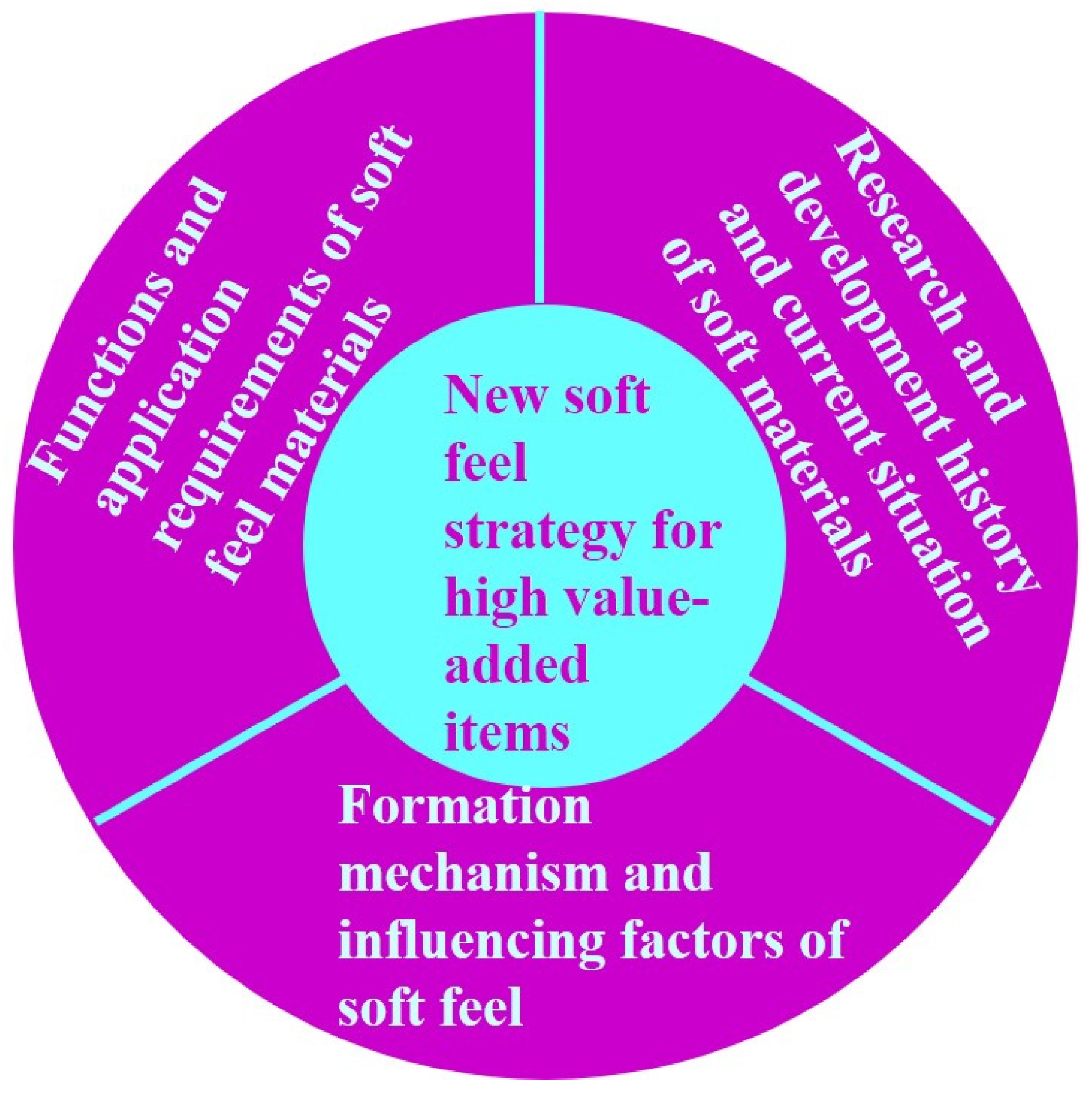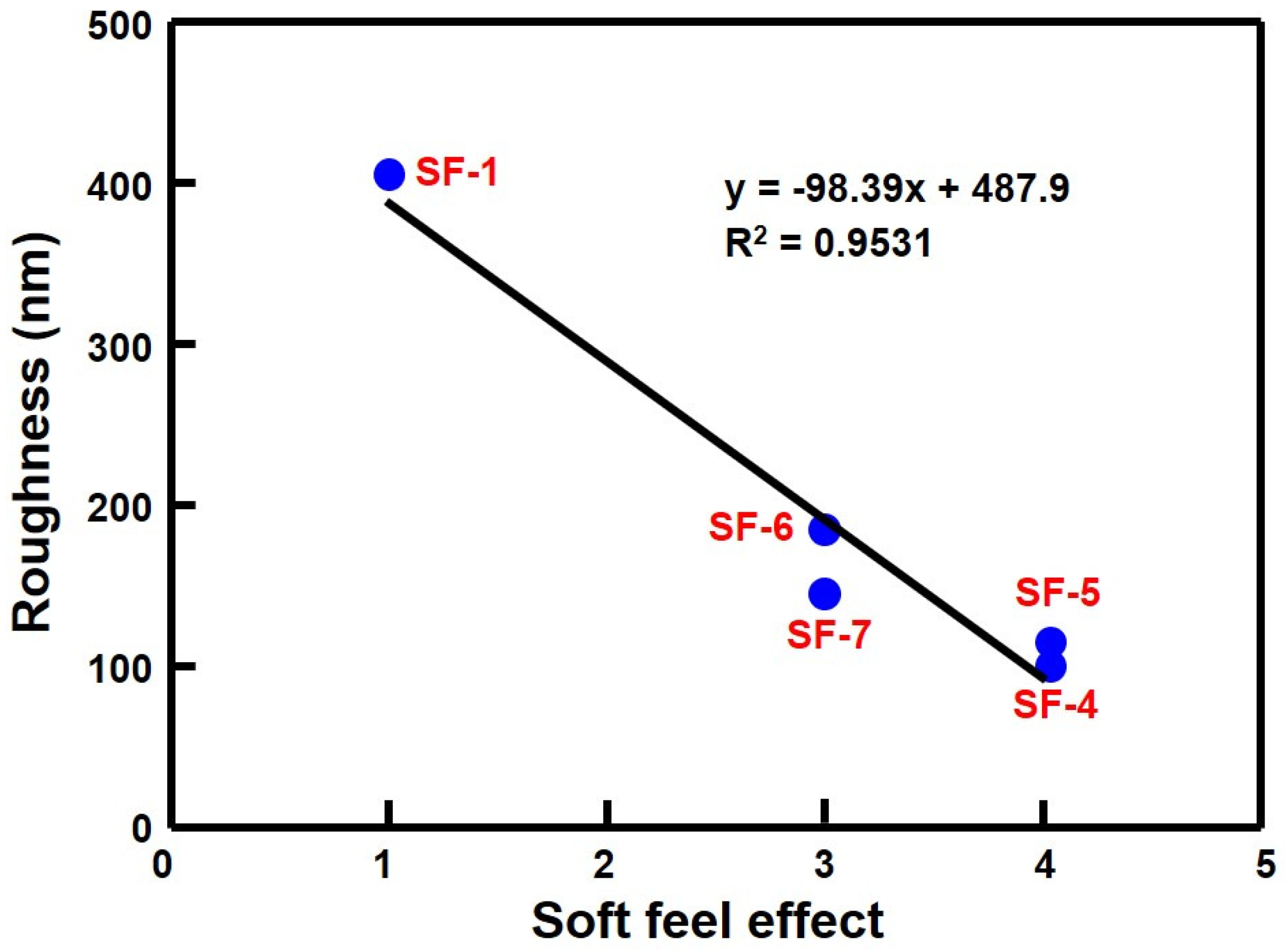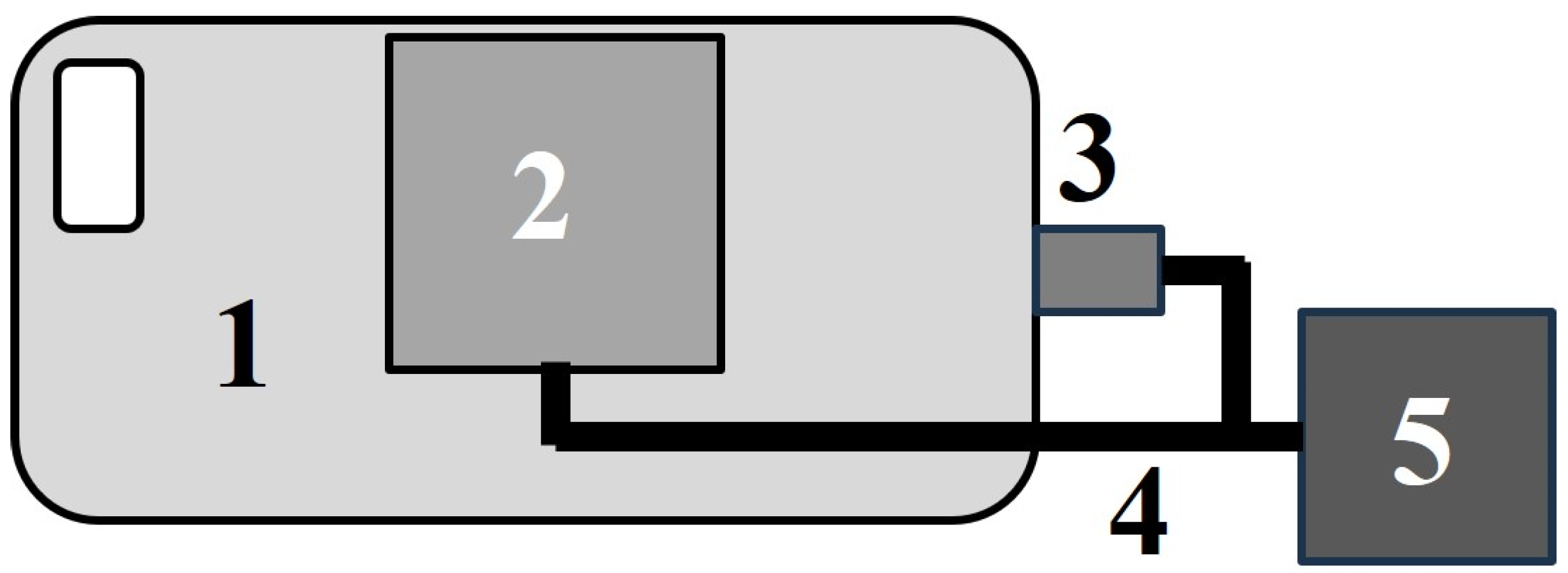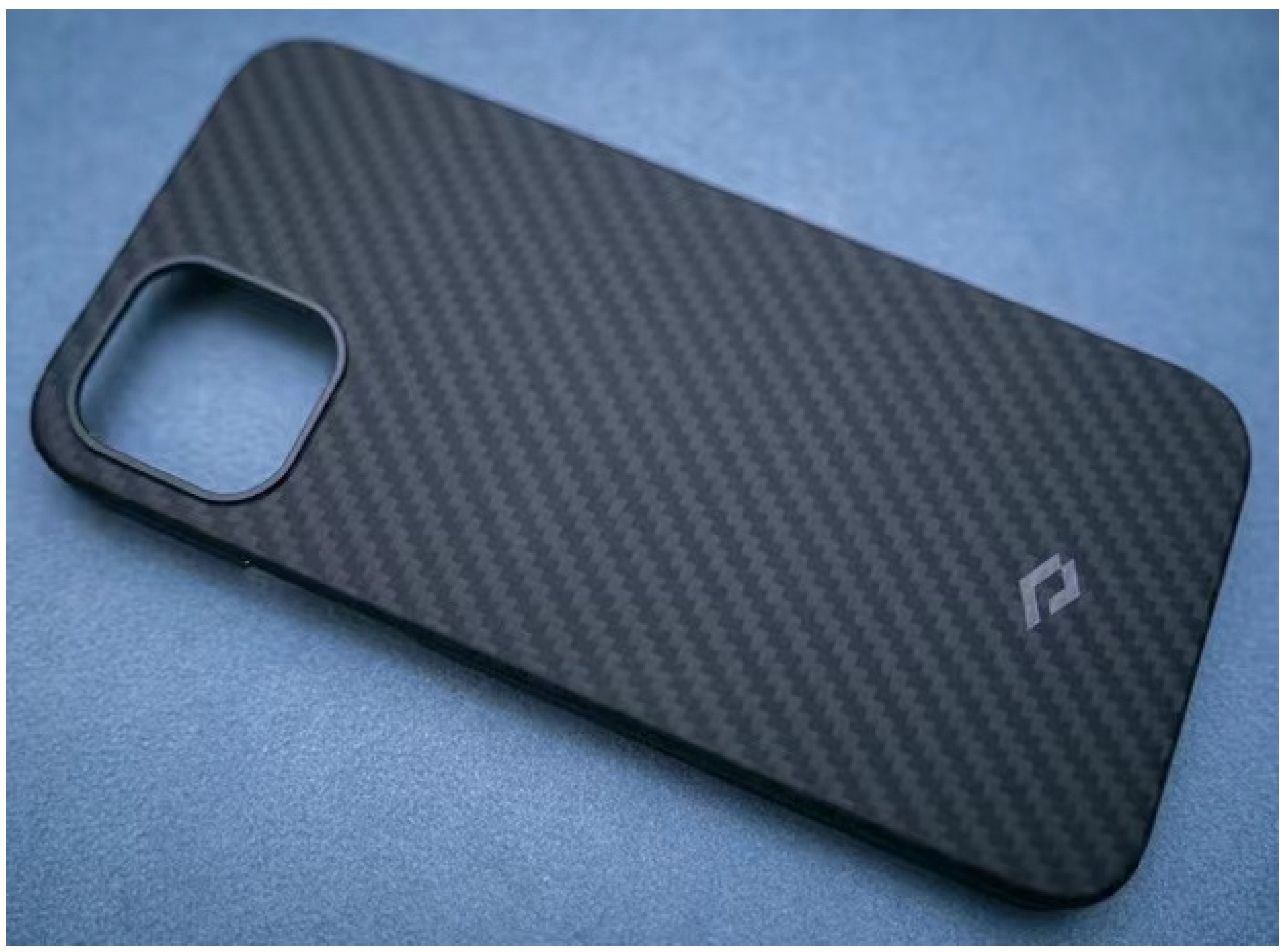Soft Feel Material Coatings on the Surface of Plastic Products and Their Application Prospects in the Popular Fields: A Review
Abstract
:1. Introduction
2. Formation Mechanisms and Influencing Factors of Soft Feel
3. Design, Preparation, and Characterization of PU Soft Feel Materials
3.1. The Basic Composition of PU Soft Feel Materials
3.2. Specific Formula, Performance Testing, Preparation Methods, and Research and Development Progress of PU Soft Feel Materials
3.2.1. The Specific Formula of PU Soft Feel Materials
3.2.2. Performance Testing of PU Soft Feel Materials
3.2.3. Preparation Methods and Research Progress of PU Soft Feel Materials
4. The Application of Soft Feel Materials in Popular Fields Such as Mobile Phone Cases
5. Discussion and Outlook
6. Conclusions
Supplementary Materials
Funding
Data Availability Statement
Conflicts of Interest
List of Abbreviations
| ABS | acrylonitrile butadiene styrene copolymer |
| AFM | atomic force microscope |
| BDO | butanediol |
| BOPP | biaxially oriented polypropylene |
| CF | carbon fiber |
| DBTDL | dibutyltin dilaurate |
| DMPA | dihydroxymethylpropionic acid |
| ESM | eggshell membrane |
| FTIR | Fourier transform infrared spectroscopy |
| GF | glass fiber |
| HDI | hexamethylene diisocyanate |
| HTS | high tactile sensation |
| IPDI | isophorone diisocyanate |
| LTS | low tactile sensation |
| NCL | non-conductive electroplating spray laser engraving |
| PAA | polyacrylic acid |
| PC | polycarbonate |
| PDMS | polydimethylsiloxane |
| PETA | pentaerythritol triacrylate |
| PP | polypropylene |
| PPO | polyphenylene oxide |
| PTMG | polytetrahydrofuran ether glycol |
| PU | polyurethane |
| SR | silicone rubber |
| TEA | triethylamine |
| TPM | tribological probe microscope |
| TPO | thermoplastic polyolefin |
| TPU | thermoplastic polyurethane |
| UV | ultraviolet light |
| VOC | volatile organic compounds |
| WBPU | waterborne polyurethane |
References
- Kawada, J.; Kitou, M.; Mouri, M.; Ario, T.; Kato, K. Invention of biobased polymer alloys and their application in plastic automobile parts. Polym. J. 2023, 55, 753–760. [Google Scholar] [CrossRef]
- Thomas, J.; Patil, R.S.; John, J.; Patil, M. A comprehensive outlook of scope within exterior automotive plastic substrates and its coatings. Coatings 2023, 13, 1569. [Google Scholar] [CrossRef]
- Li, D.; Qu, G.; Che, S.; Wang, Y.; Ding, J. Critical review of heat-resistant and mechanical properties of acrylonitrile-butadiene-styrene (ABS) modification for fused deposition modeling (FDM). Polymer 2023, 47, 553–564. [Google Scholar] [CrossRef]
- Shu, H.; Wang, B. Introduction and development of elastic touch coatings. Henan Chem. Ind. 2017, 34, 17–19. (In Chinese) [Google Scholar]
- Zhao, Y. Surface modification of the BOPP laminated film via coating method and its application progress. Aging Appl. Synth. Mater. 2023, 52, 98–102. (In Chinese) [Google Scholar]
- Li, J.; Wong, W.-Y.; Tao, X.-M. Recent advances in soft functional materials: Preparation, functions and applications. Nanoscale 2020, 12, 1281–1306. [Google Scholar] [CrossRef] [PubMed]
- Wang, J. Material Innovation for the soft wind instrument, Suona. J. Shenyang Norm. Univ. 2015, 39, 186–188. (In Chinese) [Google Scholar]
- Essick, G.K.; McGlone, F.; Dancer, C.; Fabricant, D.; Ragin, Y.; Phillips, N.; Jones, T.; Guest, S. Quantitative assessment of pleasant touch. Neurosci. Biobehav. Rev. 2010, 34, 192–203. [Google Scholar] [CrossRef] [PubMed]
- Cavdan, M.; Drewing, K.; Doerschner, K. The look and feel of soft are similar across different softness dimensions. J. Vis. 2021, 21, 20. [Google Scholar] [CrossRef] [PubMed]
- Bai, H.; Zheng, Z.; Yang, F.; Ruan, J. Research on the evaluation methods of skin sensory board coatings. China Artif. Board 2022, 29, 24–28. (In Chinese) [Google Scholar]
- Liu, X.; Chan, M.K.; Hennessey, B.; Rubenach, T.; Alay, G. Quantifying touch-feel perception on automotive interiors by a multi-function tribological probe microscope. J. Phys. Conf. Ser. 2005, 13, 357–361. [Google Scholar] [CrossRef]
- Mirabedini, A.; Mohseni, M.; Ramezanzadeh, B. A comparative study between experimentally measured mechanical attributes and users’ perception of soft feel coatings: Correlating human sense with surface characteristics of polyurethane based coatings. Prog. Org. Coat. 2013, 76, 1369–1375. [Google Scholar] [CrossRef]
- Arakawa, N.; Saito, N.; Okamoto, S. Less frictional skin feels softer in a tribologically paradoxical manner. IEEE Access 2022, 10, 55279–55287. [Google Scholar] [CrossRef]
- Hashim, I.H.M.; Kumamoto, S.; Takemura, K.; Maeno, T.; Okuda, S.; Mori, Y. Tactile evaluation feedback system for multi-layered structure inspired by human tactile perception mechanism. Sensors 2017, 17, 2601. [Google Scholar] [CrossRef] [PubMed]
- Lin, X.; Xia, Z.; Xing, J.; Zhang, Y. Research and development of waterborne soft feel coatings for ABS plastics. Coat. Ind. 2013, 43, 46–49. (In Chinese) [Google Scholar]
- Wang, Z.; Xu, Z.; Huang, L. Research progress on the coating materials and their processes for the automotive interior and exterior design. Surf. Technol. 2019, 48, 338–345. (In Chinese) [Google Scholar]
- Jamshidian, M.; Thamburaja, P.; Rabczuk, T. A multiscale coupled finite-element and phase-field framework to modeling stressed grain growth in polycrystalline thin films. J. Comput. Phys. 2016, 327, 779–798. [Google Scholar] [CrossRef]
- Xia, Y.; Zuo, J.; Yang, C.; Wu, K.; Liu, G.; Sun, J. Influence of thermal annealing on the microstructure evolution, fracture and fatigue behavior of nanocrystalline Cu films. Mater. Today Commun. 2023, 36, 106793. [Google Scholar] [CrossRef]
- Na, W.S.; Sinha, T.K.; Lee, J.; Oh, J.S. Eggshell membrane reinforced polypropylene biocomposite and its tactile assessment. J. Appl. Polym. Sci. 2020, 137, e49508. [Google Scholar] [CrossRef]
- Wang, Y.; Liu, H.; Zhang, H.; Zhu, B.; Xu, F.; Zhuang, Z. Development of two-component soft feel coatings for ABS plastics. Shanghai Coat. 2015, 53, 24–27. (In Chinese) [Google Scholar]
- Farbenindustrie, I.G. Verfahrenzur Herstellung von Polyurethanenebzw, Polyharnstoffen. Patent DE728981, 7 December 1942. [Google Scholar]
- Xu, X.; Fan, P.; Ren, J.; Cheng, Y.; Ren, J.; Zhao, J.; Song, R. Self-healing thermoplastic polyurethane (TPU)/polycaprolactone (PCL)/multi-wall carbon nanotubes (MWCNTs) blend as shape-memory composites. Compos. Sci. Technol. 2018, 168, 255–262. [Google Scholar] [CrossRef]
- Wang, T.; Liu, Y.; Zhao, J.; Zhang, H.; Zhang, Z. A facile approach to fabricate two-way shape memory polyurethane with large reversible strain and high shape stability. Smart Mater. Struct. 2020, 29, 055033. [Google Scholar] [CrossRef]
- Wang, T.; Zhao, J.; Weng, C.; Wang, T.; Liu, Y.; Han, Z.; Zhang, Z. Three-dimensional graphene coated shape memory polyurethane foam with fast responsive performance. J. Mater. Chem. C 2021, 9, 7444–7451. [Google Scholar] [CrossRef]
- Wang, T.; Zhao, J.; Weng, C.; Wang, T.; Liu, Y.; Han, Z.; Zhang, Z. A bidirectionally reversible light-responsive actuator based on shape memory polyurethane bilayer. Compos. Part A 2021, 144, 106322. [Google Scholar] [CrossRef]
- Yang, X.; Han, Z.; Jia, C.; Wang, T.; Wang, X.; Hu, F.; Zhang, H.; Zhao, J.; Zhang, X. Preparation and characterization of body-temperature-responsive thermoset shape memory polyurethane for medical applications. Polymers 2023, 15, 3193. [Google Scholar] [CrossRef] [PubMed]
- Autumn; Rudlong, M.; Julie; Goddard, M. Synthesis and characterization of hydrophobic and low surface tension polyurethane. Coatings 2023, 13, 1133. [Google Scholar] [CrossRef]
- Nam, H.J.; Hwangbo, H.; Nam, Y.; Hyun; Nam, M. Development and performance evaluation of stretchable silver pastes for screen printing on thermoplastic polyurethane films. Coatings 2023, 13, 1499. [Google Scholar] [CrossRef]
- Rapp, M.; Voigt, A.; Dirschka, M.; de Carvalho, M.D.S. The use of polyurethane composites with sensing polymers as new coating materials for surface acoustic wave-based chemical sensors—Part I: Analysis of the coating results, sensing responses and adhesion of the coating layers of polyurethane-polybutylmethacrylate composites. Coatings 2023, 13, 1911. [Google Scholar] [CrossRef]
- Chen, L. Formula design and optimization of an elastic touch paint. Chem. Intermed. 2010, 10, 56–61. (In Chinese) [Google Scholar]
- Zhou, M.; Jiao, Q.; Zhao, Y.; Cui, W. Preparation and properties of waterborne two-component polyurethane soft feel coatings. J. Beijing Inst. Technol. 2012, 32, 1294–1297. (In Chinese) [Google Scholar]
- Zhang, Y.; Chen, B.; Wang, M. Research on the elastic touch coatings for ABS. Coat. Technol. Abstr. 2013, 34, 27–29. (In Chinese) [Google Scholar]
- GB/T9286-1998; Paints and Varnishes-Scratching Test for Paint Films. Chinese National Testing Standards; State Administration for Market Regulation: Beijing, China, 1998. (In Chinese)
- GB/T6739-2006; Paints and Varnishes-Determination of Film Hardness by Pencil Method. Chinese National Testing Standards; State Administration for Market Regulation: Beijing, China, 2006. (In Chinese)
- GB/T9754-2007; Paints and Varnishes-Determination of 20°, 60°, and 85° Specular Gloss of Paint Films without Metal Pigments. Chinese National Testing Standards; State Administration for Market Regulation: Beijing, China, 2007. (In Chinese)
- GB/T1731-1993; Method for Determining the Flexibility of Paint Films. Chinese National Testing Standards; State Administration for Market Regulation: Beijing, China, 1993. (In Chinese)
- GB/T23989-2009; Determination of Solvent Wiping Resistance of Coatings. Chinese National Testing Standards; State Administration for Market Regulation: Beijing, China, 2009. (In Chinese)
- Xu, F.; Hu, Z.; Chen, W.; Zhuang, Z.; Zhu, B.; Zhu, K.; Zhang, H.; Yuan, Q. Research on the low surface energy UV curing waterborne soft feel plastic coatings. Shanghai Coat. 2012, 50, 5–8. (In Chinese) [Google Scholar]
- Duan, T. Liangquan packaging building the first brand in the soft feel film industry. Print. Technol. 2013, 76. (In Chinese) [Google Scholar]
- Nobel, A. Akzo Nobel’s special coatings business department launches innovative soft feel surface coatings. New Chem. Mater. 2014, 235. (In Chinese) [Google Scholar]
- Polycarbonate mobile phone cases have a metallic texture. Glob. Polyurethane 2017, 48. (In Chinese)
- Chen, Q. Research on the color and material of smartphone case. China Sci. Technol. Inf. 2014, 187. (In Chinese) [Google Scholar]
- Wei, Z.; Yuan, S.; Dong, Y.; Pan, Y.; Wu, X.; Li, X. A method for making a mobile phone case with thermal insulation and heating function. J. Jiamusi Univ. 2018, 36, 418–419+439. (In Chinese) [Google Scholar]
- Zheng, Y.; Zheng, Y.; Shao, L.; Qiu, S.; Zheng, J.; Liu, Q.; Luo, W. A Kevlar Mobile Phone Protective Case with Integrated Magsafe magnet Processing Technology. Patent CN113079238A, 6 July 2021. (In Chinese). [Google Scholar]
- Duan, J.; Yan, X. Methods for eliminating gas trapping defects in the injection molding of mobile phone cases. Eng. Plast. Appl. 2015, 43, 49–53. (In Chinese) [Google Scholar]
- Han, L.; Wang, R.; Li, W.; Shi, J.; Zhao, J. Injection molding process and mold design for mobile phone cases. Technol. Innov. Appl. 2017, 87–88. (In Chinese) [Google Scholar]
- Shang, X.; Men, J.; Han, H.; Jia, Q. Flow analysis and process optimization of injection molding for mobile phone cases. Eng. Plast. Appl. 2023, 51, 75–80. (In Chinese) [Google Scholar]
- Deng, S. A brief discussion on the environmental issues and solutions in coating process of plastic and rubber mobile phone cases. Build. Mater. Decor. 2018, 205–206. (In Chinese) [Google Scholar]
- Wang, H.; Chen, Y.; Ding, B.; Pan, Y. Polycarbonate glycol (PCDL) soft feel coatings for automotive interior parts. Coatings 2008, 46, 1–4. (In Chinese) [Google Scholar]
- Zhou, R. Formula design and application of elastic tactile coating on the outer surface of the casing. Coatings 2008, 23, 45–48. (In Chinese) [Google Scholar]
- Zhou, R.; Zhong, S. Solvent-based two-component polyurethane soft feel coatings for plastic substrates. Electroplat. Coat. 2009, 28, 55–59. (In Chinese) [Google Scholar]
- Hong, W. Second layer coating of soft feel coatings on polypropylene. Coat. Ind. 2003, 33, 2–3. (In Chinese) [Google Scholar]
- Li, J. Water-based two-component polyurethane soft feel coating for automotive interior parts. Electroplat. Coat. 2008, 27, 41–43+47. (In Chinese) [Google Scholar]
- Irle, C.; Mechtel, M.; Li, J.; Liu, Q. New production process for improved soft feel coatings. Coat. Ind. 2009, 39, 48–49, 72. (In Chinese) [Google Scholar]




| References | Elastic Resin | Curing Agent | Drying Agent | Elastic Additive | Matting Powder | Leveling Agent | Diluent | Additive |
|---|---|---|---|---|---|---|---|---|
| [30] | PL1300 and PS301 | NM60 | AKL25 and AS337 | AS340 and CS554 powder | AL519 | ALF10 and AL106 | 7400 | - |
| [31] | Polyester polyols | IPDI and HDI | DBTDL | - | - | 381 (BYK, Bertelsdorf, Germany) | 190 (BYK, Germany), DMPA, N-methylpyrrolidone, TEA, and triethylenediamine | 420 anti-settling agent, 346 wetting agent, and 024 defoamer (BYK, Germany) |
| [32] | CTR6426 and CTR6428 polyester (CNOOC Changzhou Environmental Protection Coatings, China) | L75, N3390, and N75 (Bayer, Leverkusen, Germany) | DBTDL | - | OK500, OK520, and TS100 (Degussa, Dusseldorf, Germany) | 331 and 358 (BYK, Germany) | Xylene, toluene, butyl acetate, ethyl acetate, diacetone alcohol, and solvent oil S1000 | - |
| [15] | PC polyols | Aliphatic isocyanates | - | P800T podwer (Genshin, Tokyo, Japan) and wax dispersion CERAF-LOUR929 | N20 (Wacker, Germany) | 348 (BYK, Germany) | - | 190 and 191 wetting agent, 024 defoamer, and 420 thickener (BYK, Germany) |
| [20] | PAAA and hydroxyl modified PAA (CNOOC Changzhou Environmental Protection Coatings, Changzhou, China) | L75, N3390, and N75 (Bayer, Germany) | Commercially available | - | Commercially available | Organic silicon and fluorocarbon modified PAA | Commercially available | (BYK, Germany) |
| Performance | Testing Methods | References |
|---|---|---|
| Adhesion | Hundred grid knife scratching methods, levels 1–7, with level 1 being the strongest | [33] |
| Pencil hardness | 9B–9H, with 9H being the hardest | [34] |
| Glossiness (60°) | - | [35] |
| Flexibility | Level 1–7, with level 7 being the highest | [36] |
| Soft feel | Hand touch technique, level 1–5, with levels 5 being the best | - |
| Scratch resistance | Fingernail method, level 1–5, with levels 5 being the strongest | - |
| Impact resistance | - | - |
| Wear resistance | - | - |
| Water resistance | - | - |
| Solvent resistance (such as ethanol, butanone, etc.) | Number of solvent wiping cycles | [37] |
| Acid, alkali, and salt resistance | - | - |
| High temperature and high humidity resistance | - | - |
| References | Target Performances | Specific Strategies |
|---|---|---|
| [41] | Metallic texture | Depositing metal at the depth of the shell and attaching a matte metal texture baking paint to the surface. |
| [42] | Aesthetically pleasing | Baking paint, spraying various colors of paint, and sanding. |
| [43] | Keeping warm | Adding GF inside the shell to achieve thermal insulation and using SR heating plate supplied by an external electrical power. |
| [44] | Soft feel | Floating weaving Kevlar fiber for elastic polymer composite. |
Disclaimer/Publisher’s Note: The statements, opinions and data contained in all publications are solely those of the individual author(s) and contributor(s) and not of MDPI and/or the editor(s). MDPI and/or the editor(s) disclaim responsibility for any injury to people or property resulting from any ideas, methods, instructions or products referred to in the content. |
© 2024 by the authors. Licensee MDPI, Basel, Switzerland. This article is an open access article distributed under the terms and conditions of the Creative Commons Attribution (CC BY) license (https://creativecommons.org/licenses/by/4.0/).
Share and Cite
Jiang, B.; Xu, Y.; Zhang, L.; Zhou, X.; Zhang, H.; Liu, L.; Zhao, J. Soft Feel Material Coatings on the Surface of Plastic Products and Their Application Prospects in the Popular Fields: A Review. Coatings 2024, 14, 748. https://doi.org/10.3390/coatings14060748
Jiang B, Xu Y, Zhang L, Zhou X, Zhang H, Liu L, Zhao J. Soft Feel Material Coatings on the Surface of Plastic Products and Their Application Prospects in the Popular Fields: A Review. Coatings. 2024; 14(6):748. https://doi.org/10.3390/coatings14060748
Chicago/Turabian StyleJiang, Bangzheng, Yueyang Xu, Lanlan Zhang, Xing Zhou, Hui Zhang, Luqi Liu, and Jun Zhao. 2024. "Soft Feel Material Coatings on the Surface of Plastic Products and Their Application Prospects in the Popular Fields: A Review" Coatings 14, no. 6: 748. https://doi.org/10.3390/coatings14060748
APA StyleJiang, B., Xu, Y., Zhang, L., Zhou, X., Zhang, H., Liu, L., & Zhao, J. (2024). Soft Feel Material Coatings on the Surface of Plastic Products and Their Application Prospects in the Popular Fields: A Review. Coatings, 14(6), 748. https://doi.org/10.3390/coatings14060748









